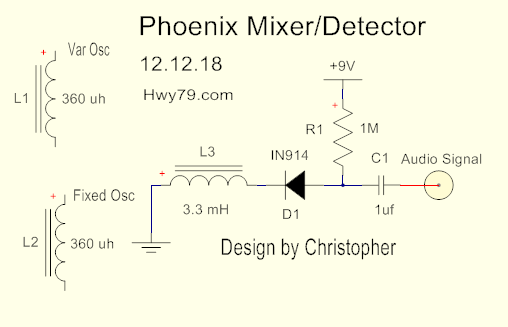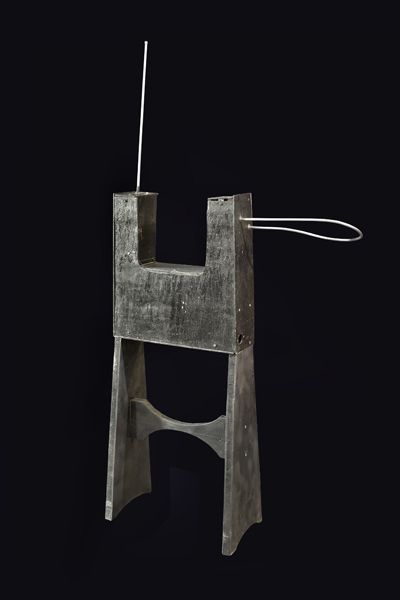Build an Analog Theremin that Rivals a Modern Day Classic for about $100
I got the answer I was looking for, my pitch antenna method is a parallel arrangement as connecting the antenna base through a 3.3 mh high Q choke to ground completely stabilizes the theremin eliminating any external noise (50/60 hz) with perfect pitch field linearity.
The intimacy is so much better than the EWS something unusual is being experienced.
Edit: The waveform I am after would not develop correctly all the time, it was almost illusive. This Ant base grounding solved the issue like the oscillator was constipated without it, now it can breathe. Also the 900 khz is now not so critical, maybe 850 khz to 950 khz, I do not know the boundaries. I would think static discharge also gets its ass slapped into place. D took the antenna's name so you force me to call it the Becker Electrode Theremin Antenna or BETA electrode or The β Antenna. This phenomenon will be verified in January 2019, those involve will be part of theremin history.
Christopher
"Build an Analog Theremin that Rivals a Modern Day Classic for about $100"
When making my first guitar amplifier, I started with the assumption I want to make the best guitar amplifier I can make and try to make it cheap. The reality showed me it is impossible to meat both goals. That because vacuum tube needs good quality components, and such components are expensive, especially the high voltage ones needed for tubes. It is more, just for the output transformer for a class B push-pull of 2 x 6L6, only the metal sheets to make it, if you want the best quality, was costing around 80$ at that time (in 2000). And to get the most out of the push-pull, you need an EL84 driver with a class A transformer, which is also costy, and a third transformer for the supply. That imply to make a cheap theremin or whatever device, I will not be using vacuum tubes but transistors. Another advantage of the transistors is than the chassis can be cheaper. Tubes are relatively big, heavy and fragiles, which imply you must have a first class chassis on the long run, and that also have its cost.
I figured out a few more things this week that I did that are somewhat original.
This approach I used with my vacuum tube and solid state theremins. That is how I got from 100v down to .6 volts, induction coupling. After I finish re-doing the PDF to make your own circuit boards I will have to leave it to someone else to redraw the schematic. If I could in my autotrax DEX software from a schematic a button is pressed and it layouts and makes the circuit board 3-D graphic to gerber files, seems cool to me. I have evolved with them over 15 years.
I have a sound texture knob which goes from a smooth sine wave to really edgy violin. This is done passively with the mixer.
Christopher 
Hwy79.com

"Mounds of human heads are wandering into the distance.
I dwindle among them. Nobody sees me. But in books
much loved and in children's toys I shall rise
from the dead to say the sun is shining."
Osip Mandelstam of Russia 1891-1938
Hallo Christoper,
is your theremin part of Gaudi's digital "Open. Theremin." project? Link Open Theremin V3
Because it has the Open Theremin-logo? will your theremin be an analog one, or do you also use an Arduino? Has it MIDI-out?
Gerd
Logo from your project site:

I waited so long, she always said it is not time... yet. Clara's voice was a gift to me, that is why that old theremin of Dorit Chrysler no longer has Clara's sound. This video is performed by my friend Valery S in St Petersburg Russia, home of the theremin, about an hour ago. It is sitting on top of the packing box it arrived in. The fat pitch antenna is the Electrodeum, not what it appears to be, where magic hides. I shared this with several engineers over the years, they were too constipated to understand.
http://www.oldtemecula.com/theremin2020/index.htm
Christopher
Hi, Christopher! I did not expect this video to appear here. Indeed, as soon as
I received the package and I managed to connect everything, I tried to play something
on Phoenix. Perfectly working environment, without preparation and rehearsals.
I'm just starting to get used to the features of the linearity of this tool, so there
are some irregularities in the performance. It is worth noting that doing something on
Phoenix is pretty easy. The sound is very similar to the violin and I like it. I think
this idea will find further development. In March, at the second concert of the festival
dedicated to the 100th anniversary of the invention of the thereminvox in St. Petersburg,
I will try to show the Phoenix to the family of Lev Sergeyevich Theremin.
We have already agreed on this meeting! For the remaining time I will try to conjure a little
over the scheme and I need to come up with the exterior design of the box ...
I must say, I find that video fascinating!
From that viewing angle of the camera, it looks like the tone spacing is somewhat small, but that's perhaps only a tuning issue. It's also difficult to judge the volume response since the player "pumps" almost every single note up to a relatively constant volume (or the recording did volume leveling), so that the dynamic response is difficult to "see". In ever case, it's very good for a first "hands on" and I'm "complaining" at a very sophisticated level.
The violin-like timbre is very beautiful and my overall impression is that I should perhaps get or build one, too. If only the days had more than 24h...
Hi, Thierry! This is really recorded without any preparation and fine-tuning of the instrument. Volume adjustment can be changed over a wide range, but I wanted to try Phoenix in action faster and I almost did not do it. All this was performed on a piece of wire instead of a volume antenna that needs to be done. In the near future, I will assemble a “mockup version”, where the elements will have a rigid fixation and i will try to record another video. In addition, the feeling of linearity of the neck is somewhat different and you need to get used to it a little.
You must be logged in to post a reply. Please log in or register for a new account.





